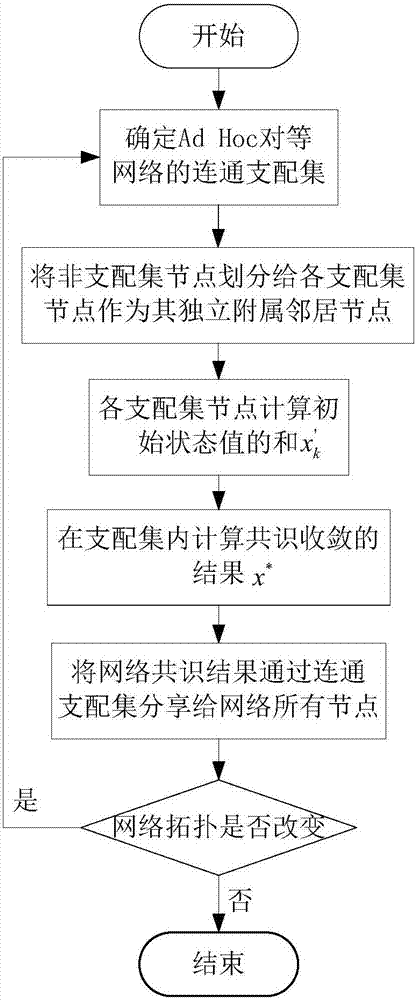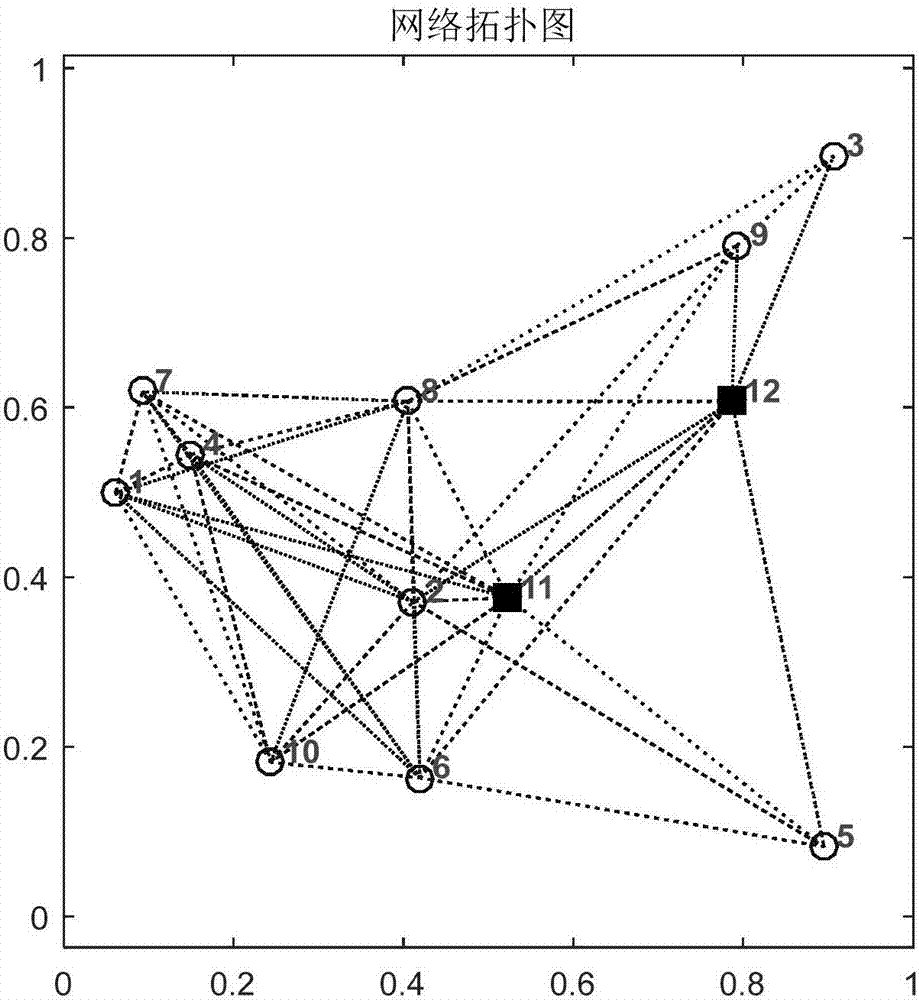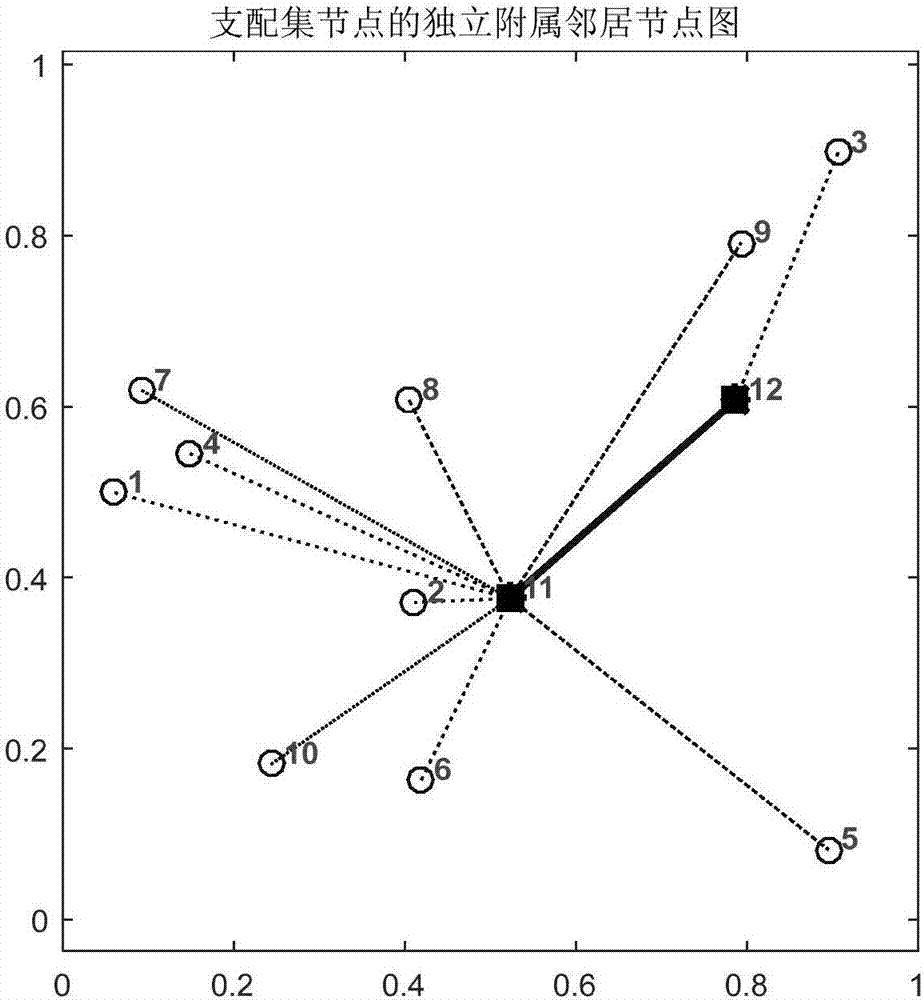Ad Hoc peer-to-peer network center-less distributed quick corecognition method
A peer-to-peer network and distributed technology, applied in the field of communication, can solve the problems affecting the performance and application scope of the decentralized distributed consensus method, the low efficiency of the network distributed consensus algorithm, and the slow convergence speed of the algorithm, so as to reduce the number of nodes and The amount of information interaction, the avoidance of network traffic, and the effect of good real-time performance
- Summary
- Abstract
- Description
- Claims
- Application Information
AI Technical Summary
Problems solved by technology
Method used
Image
Examples
Embodiment 1
[0032] Based on the original algorithm in the Ad Hoc peer-to-peer network in the information diffusion link and iterative calculation link, when the number of network nodes is large and the information diffusion path is very long, it will cause slow information diffusion speed, slow algorithm convergence speed, information loop calculation, and node calculation. Problems such as large size and high energy consumption of nodes lead to the disadvantages of low efficiency, high energy consumption, and poor real-time performance in the distributed consensus process of the network.
[0033] The above defects have affected the performance and application range of the decentralized consensus method based on the Ad Hoc peer-to-peer network, and even make the algorithm invalid when the situation is bad. For this reason, the present invention proposes a kind of Ad Hoc peer-to-peer network non-center distributed fast consensus method through repeated exploration and innovation, see figur...
Embodiment 2
[0043] Ad Hoc peer-to-peer network non-central distributed fast consensus method is the same as embodiment 1, the calculation of the initial state value sum of the dominant set node and the independent affiliated neighbor node in step 3 is specifically: use the state variable x i Indicates the initial state value of network node i, for connected dominator set node k, k=1,..., |V′|, |V′| is the number of nodes in dominator set V’, independent subordinate neighbors of dominator set node k denoted as F k ,|F k |Indicates the number of independent subordinate neighbors of the dominating set node k; each dominating set node k performs the calculation:
[0044]
[0045] where x' k Indicates the sum of the initial state values of the dominating set node k and its independent affiliated neighbor nodes, x k is the initial state value of the dominating set node k.
[0046] The present invention utilizes network subsets to connect and dominate centralized dominating nodes to rea...
Embodiment 3
[0048] The Ad Hoc peer-to-peer network non-central distributed fast consensus method is the same as that of Embodiment 1-2, and the information sharing convergence model in step 4 is specifically: the initial state values of all dominating set nodes k and their independent affiliated neighbor nodes and their sums are combined with the network The ratio of all node numbers. In other words, the initial state values of all nodes in the network are non-repeatedly summed through the dominating set.
[0049] According to the initial state value and the same calculation performed on each node of the connected dominator set, the information sharing convergence model calculation is performed in the connected dominator set to obtain the consensus convergence result:
[0050]
[0051] where x * Indicates the result of Ad Hoc peer-to-peer wireless network consensus convergence.
[0052] The present invention utilizes the dominant node to realize the full coverage and non-repetiti...
PUM
 Login to View More
Login to View More Abstract
Description
Claims
Application Information
 Login to View More
Login to View More - R&D
- Intellectual Property
- Life Sciences
- Materials
- Tech Scout
- Unparalleled Data Quality
- Higher Quality Content
- 60% Fewer Hallucinations
Browse by: Latest US Patents, China's latest patents, Technical Efficacy Thesaurus, Application Domain, Technology Topic, Popular Technical Reports.
© 2025 PatSnap. All rights reserved.Legal|Privacy policy|Modern Slavery Act Transparency Statement|Sitemap|About US| Contact US: help@patsnap.com



